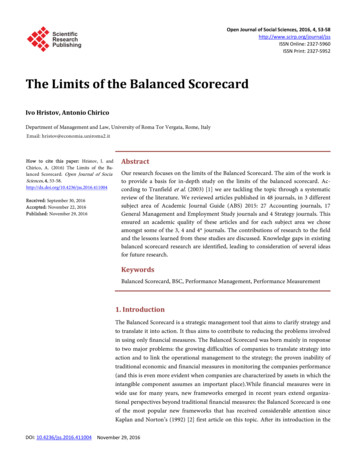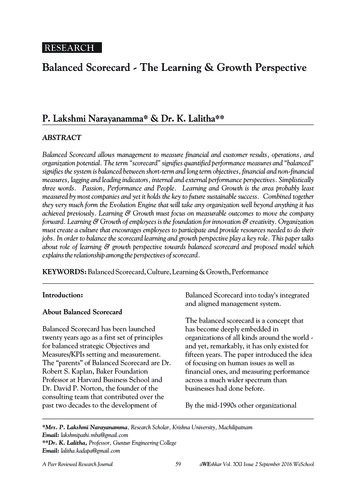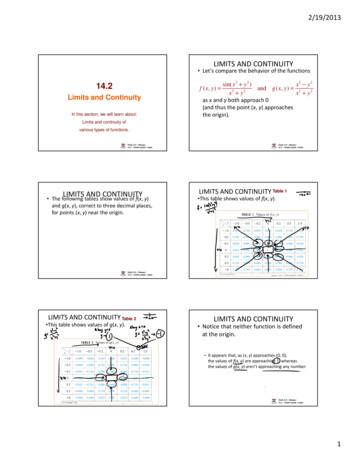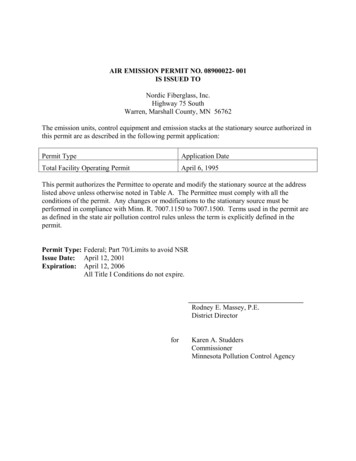
Transcription
Open Journal of Social Sciences, 2016, 4, 53-58http://www.scirp.org/journal/jssISSN Online: 2327-5960ISSN Print: 2327-5952The Limits of the Balanced ScorecardIvo Hristov, Antonio ChiricoDepartment of Management and Law, University of Roma Tor Vergata, Rome, ItalyHow to cite this paper: Hristov, I. andChirico, A. (2016) The Limits of the Balanced Scorecard. Open Journal of SociaSciences, 4, eived: September 30, 2016Accepted: November 22, 2016Published: November 29, 2016AbstractOur research focuses on the limits of the Balanced Scorecard. The aim of the work isto provide a basis for in-depth study on the limits of the balanced scorecard. According to Tranfield et al. (2003) [1] we are tackling the topic through a systematicreview of the literature. We reviewed articles published in 48 journals, in 3 differentsubject area of Academic Journal Guide (ABS) 2015: 27 Accounting journals, 17General Management and Employment Study journals and 4 Strategy journals. Thisensured an academic quality of these articles and for each subject area we choseamongst some of the 3, 4 and 4* journals. The contributions of research to the fieldand the lessons learned from these studies are discussed. Knowledge gaps in existingbalanced scorecard research are identified, leading to consideration of several ideasfor future research.KeywordsBalanced Scorecard, BSC, Performance Management, Performance Measurement1. IntroductionThe Balanced Scorecard is a strategic management tool that aims to clarify strategy andto translate it into action. It thus aims to contribute to reducing the problems involvedin using only financial measures. The Balanced Scorecard was born mainly in responseto two major problems: the growing difficulties of companies to translate strategy intoaction and to link the operational management to the strategy; the proven inability oftraditional economic and financial measures in monitoring the companies performance(and this is even more evident when companies are characterized by assets in which theintangible component assumes an important place).While financial measures were inwide use for many years, new frameworks emerged in recent years extend organizational perspectives beyond traditional financial measures: the Balanced Scorecard is oneof the most popular new frameworks that has received considerable attention sinceKaplan and Norton’s (1992) [2] first article on this topic. After its introduction in theDOI: 10.4236/jss.2016.411004 November 29, 2016
I. Hristov, A. Chiricoearly 90s, it has attracted considerable interest among companies in recent years, andhe has also generated enormous interest in academic and industrial communities (Barnabe & Busco, 2012; Kraus & Lind, 2010; Malina, Norreklit & Selto, 2007, Norreklit,Mitchell, & Bjomenak, 2012; Salterio, 2012) [3] [4] [5] [6] [7]. With the increase inpopularity, the BSC has evolved from a simple performance measurement system to astrategic management system (Kaplan & Norton, 2001a) [8]. The BSC has also receivedmuch criticism over the years. This includes its a-theoretical approach and its detachment from accounting numbers. These criticisms indicate that the application of theBSC might not be as easy as Kaplan and Norton postulate, thereby giving us anothergood reason to survey the literature for evidence from the field.Our goal is to expand upon these previous reviews and to provide a basis for indepth study on the limits of the balanced scorecard. Only limited systematic researchhas been done on BSC limits. First of all we selected studies related to the balanced scorecard published in Accounting, General Management and Strategy journals. In thesecond step, papers are analysed to see if show limits about BSC. Then we identify onlythe paper that highlights the limits related to the BSC. In the final section, we presentour conclusion and discuss how to analyze papers. Finally we identify research gaps andsuggest further ideas for future research.2. Methodology2.1. Systematic Literature ReviewAccording to Tranfield et al. (2003) [1] we are tackling the topic through a systematicreview of the literature. (Denyer & Tranfield, 2009; Lueg & Schäffer, 2010; Rousseau,Manning, & Denyer, 2008; Tranfield, Denyer, & Smart, 2003) [1] [9] [10] [11]. Systematic reviews differ from traditional narrative reviews by adopting a replicable, scientific and transparent process. In other words a detailed technology, that aims to minimize bias through exhaustive literature searches of published and unpublished studies and by providing an audit trail of the reviewers decisions, procedures and conclusions (Cook, Mulrow and Haynes, 1997) [12]. First of all, we can find the answer in theunderstanding of the complex meaning of findings and researches when conduct whenwe write on this kind of topic. The usage of the findings we provide is important forpromote research, support practice and contribute to the construction of a solid theory.It provides a strong reference context and legitimizes our research questions.2.2. The Steps of the WorkIn order to obtain a complete and exhaustive review, this work will be realised by enclosing all the main elements that have been the subjects of the main discussions andresearches. Our literature search comprised three steps: areas chosen for the source,choice of electronic sources, literature search procedure.2.3. Areas ChosenAccounting, General Management and Strategy are the areas chosen for the source54
I. Hristov, A. Chiricoranked by Academic Journal Guide-2015 (ABS), thanks to its outstanding, reliabilityand appreciation in the European scientific community. For each subject area we ensured an academic quality and only considered journals that were ranked with 3 and 4stars on the ranking of the Association of Business Schools. The choice was guided by apanel of expert on the field. This criterion afforded also a selection which aimed atconducting our study through leading sources and, at the same time, at being notstrictly bounded to a very limited number of journals. Eventually, we countervailed thegood level of quality of the sources selected, with a comfortable but quite heterogeneousset of information to be handled.2.4. Choice of SourcesFirst of all it is suitable to explain the usefulness of the main databases that we used tofind all the articles concerning our topic and, if they were not exhaustive we went onGoogle to find more in order to have a greater range of choice. The main importantsources considered were: ScienceDirect, AAA (the digital library), Wiley online Library,Taylor and Francis online, Springer Link, Cambridge Journal, Oxford Journal, EmeraldInsight, American Economic Association and Land Economics. There are bibliographicdatabases containing a broad range of full text, abstracts and citations designed for research and academic journal articles. In some cases no sources were founded.3. Literature Search ProcedureIn this work we reviewed articles published in 48 journals, in 3 different subject area ofAcademic Journal Guide (ABS)-2015: 27 Accounting journals, 17 General Managementand Employment Study journals and 4 Strategy journals. The focus of our review wason publications that explicitly concentrated on the balanced scorecard. Our literaturesearch began using the terms “Balanced Scorecard, “BSC”, “Performance Management”and “Performance Measurement” and was based on articles published by an individualjournal and available on its web homepage. We entered the above exposed keywords inthe search bar and we set the filters. We applied some subjective criteria in our selectionof journal. After putting the keywords on the search bar, the output of the search hadan further step, which was that of select all the journal that contained in Title, Abstractor Keywords the following words: “Balanced Scorecard’’ ‘’BSC’’ and “Scorecard”. Thisyielded 122 articles. We focus on the 122papers selected in order to identify only thepaper facing the limits of BSC.Limit DefinitionFinally we conclude with a brief definition of the term “limit” in its negative connotation that moves the idea more to the terms failure and weaknesses. It’s important because we want to better explain what was our interest and motivation in the selection ofthe papers talking about this topic. The definition of limit like a “particular part orquality that is not good or effective, a quality or feature that prevents from being effec55
I. Hristov, A. Chiricotive or useful” allowed me to select the articles in which this negative connotation waspresent with its shades (weaknesses, failure, limitation ) defined and delimited theborders met by the balanced scorecard. This is the criterion for inclusion paper in thesample. Then we selected only the paper that highlight the limits connected to the BSC.We got 69 papers and only those papers are the subject of our analysis.4. Findings ReviewIn the following, we categorize the findings of the identified articles according to ourframework. We examined 5625 papers, limited to title, abstract and keywords. Thisyelded 122 articles. We focused on the 122 papers selected in order to identify only thepaper facing the limits of BSC. We analyzed 48 journals, 14 four stars and 34 threestars. Table 1 summarizes these results.The area with the highest number of selected papers is ACCOUNTING, which hascontributed with 97 papers, in percentage terms 2.75 compared to the total of foundpaper, General Management has contributed with 10 papers and finally Strategy whichhas contributed with 15 papers. Table 2 highlights areas frequency distribution.In the second step, papers are analysed to see if they show limits about BSC. We selected only papers that highlight the limits connected to the BSC. We got 60 papers andonly those papers are the subject of our analysis. The criterion that allowed the inclusionof papers in the sample is the definition of limits generating the inclusion area. Thesewere physically analysed to understand if to highlight the limits of the scorecard, and thenselected. The analysis procedure was as follows: title, keywords, abstract, conclusion, introduction and in the end reading individual paragraphs. At the end of this phase 60 papers were included in the sample. Table 3 highlights limits frequency distribution.Table 1. Data on Subject Areas (ABS Academic Journal Guide 2015).AREASJOURNAL SELECTEDRATE 4RATE 3ACCOUNTING27621GENERAL MANAGEMENT17710STRATEGY413TOT481434AREASPAPER FOUNDPAPER SELECTEDPERCENTAGE %ACCOUNTING3533972.75GENERAL 72Table 2. Areas frequency distribution.56
I. Hristov, A. ChiricoTable 3. Limits frequency distribution.AREASPAPER SELECTEDPAPER FOCUS LIMITSOF BSCPERCENTAGE %ACCOUNTING975253.61GENERAL MANAGEMENT10330.00STRATEGY15533.33TOT1226049.185. Conclusions and DiscussionThe need for a comprehensive view of performance management has been widely discussed in the popular and scholastic press. Results provide a basis for further researchfor eliminating or reducing the existing gaps in performance management. The goal isto understand what are the causes that may lead to performance management toolsfailures and therefore the implication of such a failure on the systemic management ofbusiness performance. This through evidence on BSC, as a systematic management toolof business performance. It will be interesting to analyze papers to investigate aboutlimits and to categorize them. The analysis could be carried out through Nvivo software, qualitative data analysis. After the collection of qualitative data, empirical evidence show us that it is possible to evaluate and clarify the main causes that lead to thefailure of the balanced scorecard. I am also interested in measuring impact of that failure on company performance. The most frequent negative phenomenon are: exclusivefocus on direct and programmed effects, time-related inconsistency of assessments,neglected trade-off, failure risk assessment and strong attention to the company’s valuein the company owned by financial investors. Atkinson, Waterhouse and Wells notethat the Balanced Scorecard model was incomplete because it fails to: (1) adequatelyhighlight the contributions that employees and suppliers make to help the companyachieve its objectives, (2) identify the role of the community in defining the environment within which the company works, and (3) identify performance measures to assess stakeholders’ contributions. Smith noted that The Balanced Scorecard fails to account for the role of “motivated employees”, a critical issue specially in the service sector. Finally, while the Balanced Scorecard framework provides constructs for multiplemeasures and overcoming the limitations of single measures, there is no clear provisionfor very long-term measures; the distinction between means and ends is not well defined and the model probably needs additional empirical validation. Altogether, thesereasons show what is the range of measurement dysfunction and weaknesses performance effects caused by non-holistic performance.Our approach has some limitations that might have led us to overlook or misinterpret some relevant information (Denyer & Tranfield, 2009) [9]. First, it is important toemphasize that areas chosen for the source are only three by Academic Journal Guide.The analysis should be done on all 22 areas by ABS. Furthermore it has not had accessto 56 journals and then the work is incomplete because the sample does not consider allpdf file. It is possible that some relevant articles have been left out of the databases we57
I. Hristov, A. Chiricosearched. Moreover this study focuses exclusively on balanced scorecard. It would bealso appropriate to apply this approach to other performance management tools to understand the relationship between performance management failure and business performance. Future research might use alternative tools to validate our results.AcknowledgementsThe authors gratefully acknowledge the research supports received from Department ofManagement and Law, University of Roma Tor Vergata, Italy.References[1]Tranfield, D., Denyer, D. and Smart, P. (2003) Towards a Methodology for DevelopingEvidence: Informed Management Knowledge by Means of Systematic Review. British Journal of Management, 14, 207-222. , R. and Norton, D. (1992) The Balanced Scorecard—Measures That Drive Performance. Harvard Business Review, 79.[3]Barnabe, F. and Busco, C. (2012) The Causal Relationships between Performance Driversand Outcomes: Reinforcing Balanced Scorecards’ Implementation through System Dynamics Models. Journal of Accounting & Organizational Change, 8, 8[4]Kraus, K. and Lind, J. (2010) The Impact of the Corporate Balanced Scorecard on Corporate control—A Research Note. Management Accounting Research, 21, 1[5]Malina, M.A., Norreklit, H.S.O. and Selto, F.H. (2007) Relations among Measures, ClimateControl, and Performance Measurement Models. Contemporary Accounting Research, 24,935-982. http://dx.doi.org/10.1506/car.24.3.10[6]Norreklit, H., Norreklit, L., Mitchell, F. and Bjomenak, T. (2012) The Rise of the BalancedScorecard! Relevance Gained? Journal of Accounting & Organizational Change, 8, 1[7]Salterio, S. (2012) Balancing the Scorecard through Academic Accounting Research: Opportunity Lost? Journal of Accounting & Organizational Change, 8, 3[8]Kaplan & Norton, 2001a.[9]Denyer, D. and Tranfield, D. (2009) Producing a Systematic Review. In: Buchanan; D. andBryman, A., Eds., The Sage Handbook of Organizational Research Methods, Sage, London,671-689.[10] Lueg, R. and Schäffer, U. (2010) Assessing Empirical Research on Value-Based Management: Guidelines for Improved Hypothesis Testing. Journal für Betriebswirtschaft, 60, 1-47.http://dx.doi.org/10.1506/car.24.3.10[11] Rousseau, D.M., Manning, J. and Denyer, D. (2008) Evidence in Management and Organizational Science: Assembling the Field’s Full Weight of Scientific knowledge through Syntheses. Academy of Management Annals, 2, 1[12] Cook, Mulrow and Haynes, 1997.58
Submit or recommend next manuscript to SCIRP and we will provide best servicefor you:Accepting pre-submission inquiries through Email, Facebook, LinkedIn, Twitter, etc.A wide selection of journals (inclusive of 9 subjects, more than 200 journals)Providing 24-hour high-quality serviceUser-friendly online submission systemFair and swift peer-review systemEfficient typesetting and proofreading procedureDisplay of the result of downloads and visits, as well as the number of cited articlesMaximum dissemination of your research workSubmit your manuscript at: http://papersubmission.scirp.org/Or contact jss@scirp.org
Balanced Scorecard, BSC, Performance Management, Performance Measurement 1. Introduction The Balanced Scorecard is a strategic management tool that aims to clarify strategy and to translate it into action. It thus aims to contribute to reducing the problems involved in using only financial measures. The Balanced Scorecard was born mainly in .










